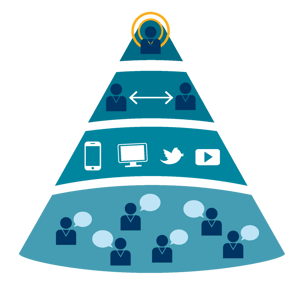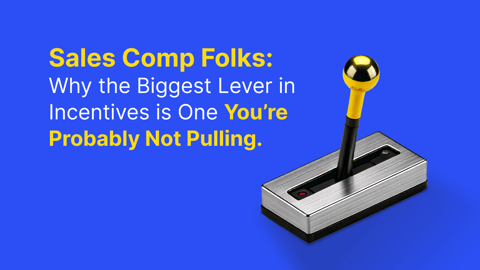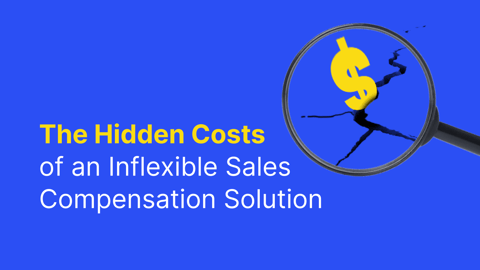Who are you and what do you do?
I'm Sangam Vajre, the co-founder and CMO of Terminus. I'm also the founder of #FlipMyFunnel.
At a deeper level, I'm someone who likes to fix problems. I like to entertain. I like to engage with people and get into spirited conversations about everything from games and sports to personal life.
How are things going over at Terminus? Are you working on anything exciting you can share with us?
We’re doing really well for an early-stage company. As a quick background, we launched our product in March 2015. We were just three co-founders, me and the two Erics: CEO and co-founder Eric Spett, and CTO and co-founder Eric Vass. Then this year, right now, we are around 60 full-time employees.
Our focus now is the transition and transformation of our organization from a product point-solution to a true ABM platform. We’re really excited about that.
That's incredible growth. You’ve got to be happy with that!
It’s certainly something that everybody thinks about, but there are all kinds of challenges and issues that come along with it that you could call “champagne” problems. For example, not being able to hire fast enough for our growth.
Absolutely. That’s a great way of putting it — champagne problems.
For sure.
It’s also made me think a lot more and given me a new, greater responsibility. It's not just the co-founders sitting in a startup shop trying to build something anymore. We've got 60-plus people whose paychecks and families depend on our success. That’s the kind of stuff I never thought about before.
Today we're going to be talking about some B2B marketing activities, processes, practices that we continue to do but maybe should reconsider. I'm going to start off with a very broad question, but one I think you'll probably have a lot to say about. What is wrong with B2B marketing today?
This is my favorite question.
I really think the best way to answer is to give a statistic that’s indisputable. This comes from Forrester: less than 1% of leads that B2B marketers generate turn into customers.
Think about that: if less than 1% of the leads that marketing generates every single month actually turn into customers, it's almost sending a signal to your C-level executive team and your board that 99% of what you do as a marketer—what I do as a marketer—doesn’t matter because it’s not impacting the bottom line.
We’re challenging the status quo of B2B marketing to say let's not get excited about all of these vanity metrics (new leads created, clicks, downloads, etc.) What we should get excited about in B2B is pipeline and revenue activities. That's really what will save the day — not just lead gen.
The #1 problem that B2B marketers have today is instant gratification. Say we’ve got 3,000 people who downloaded an infographic about Game of Thrones. That’s a great number...but how many actually are your best-fit prospects? Nobody looks into that data. Nobody takes the time to deep dive and say, “You know what? Out of the 1,000 people that downloaded our infographic, only two of them were actually best-fit accounts.”
What do you think caused it to evolve this way?
If you think about it, there’s some magic that happens every five years in marketing.
The 2000s - that’s when email popped up. Everybody said, “Great. You got an 80% open rate on emails.” This was the official rise of marketing technology.
2005 - everybody said, “Wait a minute. Can you just capture the people who actually took action on the emails?” That gave rise to marketing automation platforms where content and email marketing really drove leads. Some tool has to be created to capture those leads as a part of this mass marketing. That was the rise of marketing automation.
2010 - that’s when salespeople said, “Hey wait a minute. You guys are generating too many leads, and these leads are not the right leads. I just need the people that fit my ideal customer profile.” To solve the problem marketing created with lead gen, predictive analytics came on the scene.
2015 - fast forward to just last year, it’s now the rise of account-based marketing, which is really what excites us. In B2B you should really be able to narrow down a list of companies that you should go after. If you know those accounts, then why would you spend time on creating content that may not resonate with them?
I think we're finally getting to a point where we can be thinking about it a little more holistically. Start doing things that marketers are really hired to do, which is to target and engage people. Make sure that they're driving pipeline and revenue for the company… not just hollow leads.
I think that's a great lead-in to a term that you mentioned earlier. One that you've really made famous #FlipMyFunnel. Can you explain what flipping your funnel means?
For a start, check out #FlipMyFunnel on Twitter.
It's all about challenging the status quo. Everybody in B2B is familiar with the funnel, which is really broad at the top and narrow at the bottom. The reason why it’s broad at the top is because everybody who downloads an ebook, for example is a prospect, but they're not all prospects. They may be interested in your Game of Thronesinfographic, but not necessarily interested in buying your product.
The idea actually has a pretty good story behind it. I was flying from San Francisco to Atlanta. I was drawing something on a napkin, sitting between two drunk people which is a gre
at motivator to get in the zone. I literally drew the funnel and I flipped it.

The top is Identify. The focus here is on figuring out what are the best compani
es to go after. There areamazing companies that are out there, such as Datanyze, Social123, and LinkedIn... a lot of these companies are able to find the best companies that you want to go after.
The second stage is Expand, which is getting in front of all the decision-makers and influencers the companies that you are targeting. Not just one person because there’s an average of 7-12 buyers in a B2B purchase decision.
The third step is to Engage. People are sick and tired of getting a ton of emails and calls. There are thousands of unread emails in my inbox...they're just sitting there! To engage with people in today’s digital world, you’ve got to get visual on the right channels where your accounts are the most active, whether that’s through Facebook, articles, or videos.
The fourth step is turning your accounts into Advocates. Once you know which customers to go after, they should drive more customers for you. Really that has been a really simple philosophy, at least from my perspective.
I don't know a single marketer that has lost his job because the revenue numbers of the company are going up, right? But I know a ton of great marketers who have lost their jobs because the company’s revenue or sales numbers are going down, regardless of what a good job the marketing team is doing.
B2B marketers need to get out of our sandbox. We need to figure out how we work well with our respective sales teams. Salespeople are the ones who are driving revenue for B2B companies, so marketing needs to get more aligned.
If sales know which accounts they're going to close in the next 90 days, marketing needs to provide air cover for them. Marketing needs to do events for them and send direct mail. Sales should be saying, “Hey marketing, I love what you guys are doing for my accounts.” This doesn't happen because marketing is too busy creating infographics about Game of Thrones instead of providing value.
No campaign that marketing is running should be in a vacuum. Every single campaign should engage opportunities, excite customers, and turn them into advocates. Everything should be in conjunction with your sales and customer success team.
What about the impact on other teams in the organization? Teams like demand gen, sales enablement and operations, or even teams like product and development.
It has a significant impact on the ability and credibility for marketing.
Right now, when we talk about webinars or something like that, you’d say, “Hey, we have 500 people,” and everyone else would say, "Yay, great number!" Then everybody walks away.
Imagine if you could say, “Hey we have 500 accounts that attended the webinar and 200 of them are actual opportunities that we're trying to close. We're now going to send them a direct mail piece as a result of their engagement with us. Sales, you all have a tasked assigned to you in Salesforce so that you can call them up and thank them for attending the webinar.”
Imagine the conversation that will happen. Imagine how much interaction you're going to have because of this conversation and alignment between sales and marketing.
I think it has an amazing amount of impact on the credibility and accountability of what marketing does for the entire organization. There shouldn’t be a single campaign that marketing does that doesn’t touch at least one other department.
What's the best way to implement an account-based marketing strategy organizationally? Would it be small changes here and there? Pilot projects? Or just do a complete overhaul?
I love to talk about one simple strategy that I think every company should deploy as a pilot project: pipeline velocity. Pipeline velocity is all about progressing accounts faster through the buyer’s journey.
If you’ve got an opportunity in Salesforce and you know that they’re either going to buy from you or one of your competitors, why not go double down on these accounts? You've already spent all of this energy, time, and resources turning the account into an opportunity, why leave them now? Focusing on these opportunity accounts in the sales cycle for those 90 days (or whatever your sales cycle is) would be the least amount of money that you would spend, but the most ROI for your marketing resources.
Imagine if you send them a direct mail. Imagine you’re engaging all of the decision makers in that company for the next 90 days and look like a big fish in a small pond because none of the competitors are doing anything close to that level of personalization.
Imagine if marketing did all that. Today all of that is the responsibility of that one poor salesperson. That's where the impact of account-based marketing will be. You will have a higher win-rate, which could mean millions in revenue for your company.
The best part of that strategy is that it's so low risk, high reward for companies to try out. How does it affect the way that you actually communicate with your audience?
I like to put myself in their shoes and remember that nobody buys a product, they buy a solution or a painkiller.
If you’ve done a decent enough job selling, then you haven't sold them a product. You've actually sold them a promise that it's going to solve some of the problems that they’re facing.
With that being the context of all of this, I think from an end-user perspective. The user, your customer, expects a little bit of empathy and understanding of what’s going on. You share content that is going to truly make sense and help them — not an email blast.
How does account-based marketing affect the way your organization interacts and reports internally?
We had to create our own playbook. We know which accounts are going to be our best-fit accounts and split them into tiers: Tier 1, Tier 2, and Tier 3.
Tier 1 - target companies with certain specifications that our sales and marketing team are really focused on.
Tier 2 - we’re warming them up but not too focused on them.
Tier 3 - something that we will get to if we have exhausted Tier 1 and Tier 2.
All of our marketing and sales people are really focused on a set of accounts that we know are our target accounts. We ask: how much revenue in those tiers are we able to impact? Are we penetrating those accounts? Are we in 10% of those accounts? Have we penetrated 2% of those accounts? It's all about can we engage those accounts and turn those accounts into opportunities and turn those opportunities into revenue.
It's taken us out of the rat race of marketing generating more leads.
At Terminus, we haven't created an ebook in more than six months. We haven't created an infographic since Q2. The last infographic we created is our Top 40 Account-Based Marketing Superheroes, many of whom are our customers. We wanted to put them on a pedestal. We also wrote a book on ABM, Account-Based Marketing For Dummies, as a way to share content.
Where do you see things going in the future? What are some upcoming trends that you have your eye on?
It's funny, somebody asked this question to Scott Brinker and I when we were doing a book launch. As most people know, Scott Brinker is one of the most prolific writers and knowledgeable people in the #MarTech space. His answer was around robotics and machine learning… the ability to do a whole lot of stuff technically possible that wasn't possible years ago.
In some ways, I do agree, but I feel that the future is surprisingly not the technology. It’s the idea of storytelling. When people buy things, they buy purely on emotions, that's the reality of it. Sometimes people buy because they feel like they have the best people to work with. If they talk to the right sales person and the right company, and someone else in their network also uses them, that will influence them heavily.
As marketers, we need to get ahead by having the ability to tell a story in such a way that you capture the prospect's imagination, and articulate a story where they can actually see their problem being solved. It has nothing to do with the product.
It's a weird answer but I do feel storytelling is the future.
Interesting! What about your favorite resources? Any you’d like to recommend?
I recently reread, this is probably the third time, Marc Benioff's book, Behind the Clouds. It’s about how he built a billion dollar company, and it’s so beautifully written. It's almost like he's sitting in front of you and telling you the story. Everybody should buy that book. It's one of my favorites.
In terms of listening to people, I listen to Gary Vaynerchuk a lot. I think he is one of those guys who puts it as is. I've taken a lot of notes from him for my personal career development.



